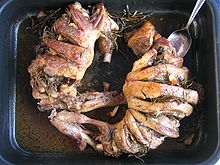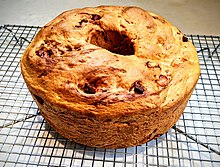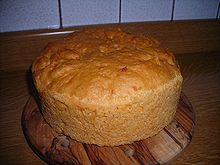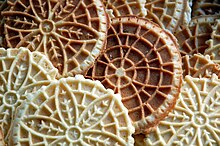Easter in Italy
 From Wikipedia - Reading time: 15 min
From Wikipedia - Reading time: 15 min

Easter in Italy (Italian: Pasqua, pronounced [ˈpaskwa]) is one of the country's major holidays.[1] Easter in Italy enters Holy Week with Palm Sunday, Maundy Thursday, Good Friday and Holy Saturday, concluding with Easter Day and Easter Monday. Each day has a special significance. The Holy Weeks worthy of note in Italy are the Holy Week in Barcellona Pozzo di Gotto and the Holy Week in Ruvo di Puglia.
Traditional Italian dishes for the Easter period are abbacchio, cappello del prete, casatiello, Colomba di Pasqua, pastiera, penia, pizza di Pasqua and pizzelle. Abbacchio is an Italian preparation of lamb typical of the Roman cuisine.[2][3] It is a product protected by the European Union with the PGI mark.[4] Eating lamb at Easter has a religious meaning; in particular, eating lamb at Easter commemorates the Death and Resurrection of Jesus.[5] Colomba di Pasqua (English: "Easter Dove") is an Italian traditional Easter bread, the Easter counterpart of the two well-known Italian Christmas desserts, panettone and pandoro.
In Florence, the unique custom of the Scoppio del carro is observed in which a holy fire lit from stone shards from the Holy Sepulchre are used to light a fire during the singing of the Gloria of the Easter Sunday Mass, which is used to ignite a rocket in the form of a dove, representing peace and the Holy Spirit, which following a wire in turn lights a cart containing pyrotechnics in the small square before the cathedral.[6] The Cavallo di fuoco is an historical reconstruction which takes place in the city of Ripatransone in the Province of Ascoli Piceno. It is a fireworks show, which traditionally occurs eight days after Easter.[7]
Holy Week
[edit]


Holy Week is observed in parts of Southern Italy, notably Sicily. The most famous is the Holy Week of Trapani, culminating in the Processione dei Misteri di Trapani or simply the Misteri di Trapani (in English the Procession of the Mysteries of Trapani or the Mysteries of Trapani). This is a day-long passion procession featuring 20 floats of lifelike sculptures made of wood, canvas and glue. These sculptures are of individual scenes of the events of the Passion, a passion play at the centre and the culmination of the Holy Week in Trapani. The Misteri are amongst the oldest continuously running religious events in Europe, having been played every Good Friday since before the Easter of 1612, and running for at least 16 continuous hours, but occasionally well beyond 24 hours, are the longest religious festivals in Sicily and in Italy.[8]
Holy Weeks worthy of note in Italy are also the Holy Week in Barcellona Pozzo di Gotto and the Holy Week in Ruvo di Puglia. The Holy Week in Barcellona Pozzo di Gotto is rooted in the history of Spanish Sicily (1516–1713) when the entire island subject to the domination of Crown of Aragon, combined with the Kingdom of Naples passes under the jurisdiction of the Crown of Spain. In 1571 "Pozzogottesi" obtained from the Grand Court of the Archbishop of Messina permission to elect their chaplain stationed in Saint Vitus no longer depend from the Archpriest of Milazzo. The first procession is carried out in 1621 as a movement of protest against the Jurors of the city of Milazzo, under whose jurisdiction Pozzo di Gotto depended politically and physically by providing a distant village and as a vow and promise to break the bond of subordination constraint which was permanently discontinued on the 22 May 1639.[9]
The rites of the Holy Week in Ruvo di Puglia are the main event that takes place in the Apulian town. Folklore and sacred or profane traditions, typical of the ruvestine tradition, represent a great attraction for tourists from neighboring cities and the rest of Italy and Europe,[10] and have been included by the I.D.E.A. among the events of the intangible heritage of Italy. The proof of the existence of the first Ruvestines confraternities can be found in the polyptych, a Byzantine work signed Z. T., depicting the Madonna with Child and confreres in which the inscription "Hoc opus fieri fec(e)runt, confratres san(c)ti Cleti, anno salut(i)s 1537" and preserved in the church of Purgatory, in the left aisle, the one dedicated to Saint Anacletus.[11]
Popular traditions
[edit]

In Italy, there are many traditions related to Easter (Italian: Pasqua). In Versilia, as a sign of forgiveness, but this time towards Jesus, the women of the sailors kiss the earth, saying: "Terra bacio e terra sono - Gesù mio, chiedo perdono" ("I kiss the earth and earth I am - my Jesus, I ask for forgiveness").[12] In Abruzzo, however, it is the custom of farmers during Easter to add holy water to food.[12] Holy water is also used in Julian March, where half a glass is drunk on an empty stomach, before eating two hard-boiled eggs and a focaccia washed down with white wine.[12]
Another symbol used during the Easter period is fire. In particular, in Coriano, in the province of Rimini, bonfires are lit on Easter Eve.[12] At the same time, the blessed fire is brought to the countryside in the autonomous province of Bolzano.[12] Bonfires are also lit in San Marco in Lamis, this time lit on a wheeled cart.[12]
In Florence, the use of sacred fire has changed over time: before the year one thousand candles were in fact brought into the houses which were lit by a candle which was, in turn, lit through a lens or a flint; at the beginning of the 14th century, instead, three pieces of flint were used that according to tradition came from the Holy Sepulcher of Jerusalem.[12] These pieces of flint were donated to the Pazzi family by Godfrey of Bouillon.[12] Later, the use of the sacred fire in Florence materialized in a chariot full of fireworks (Scoppio del carro).[12]
The Cavallo di fuoco is an historical reconstruction which takes place in the city of Ripatransone in the Province of Ascoli Piceno. It is a fireworks show, which traditionally occurs eight days after Easter.[7] The show goes back to 1682 when, on the occasion of celebrations in honor of the Virgin Mary, the local dwellers hire a pyrotechnician who, once the spectacle was over, took all his remaining fireworks and shot riding his horse. This extemporized action struck the citizens who began to recall it yearly. In the 18th century a mock steed replaced the animal and the fireworks were assembled upon it. Originally it was made of wood, and until 1932 it was carried on the shoulders of the most robust of citizens. Later it was considered more convenient to equip it with wheels and a rudder and have it towed by volunteers equipped with protective clothing and accessories. In 1994 a new sheet iron horse, built on the model of the previous one, took the place of the wooden one.[13]
Gastronomy
[edit]Abbacchio
[edit]
Abbacchio is an Italian preparation of lamb typical of the Roman cuisine.[2][3] It is a product protected by the European Union with the PGI mark.[4] In Romanesco dialect, the offspring of the sheep who is still suckling or recently weaned is called abbacchio, while the offspring of the sheep almost a year old who has already been shorn twice is called agnello ("lamb").[14] This distinction exists only in the Romanesco dialect.[14]
In Italy at Easter, abbacchio is cooked in different ways, with recipes that vary from region to region.[15] In Rome it is roasted, in Apulia in the oven, in Naples it is cooked with peas and eggs, in Sardinia it is cooked in the oven with potatoes, artichokes and myrtle and in Tuscany it is cooked in cacciatore style.[15] Other local preparations include frying and stewing.[15]
Eating lamb at Easter has a symbolic meaning. The Paschal Lamb of the New Testament is in fact, for Christianity, the son of God Jesus Christ.[16] The Paschal Lamb, in particular, represents the sacrifice of Jesus Christ for the sins of humanity.[5] Eating lamb at Easter therefore commemorates the Death and Resurrection of Jesus.[5]
Cappello del prete
[edit]Cappello del prete (sometimes called tricorno) is a variety of Italian salume typical of Parma and Piacenza. It is recognized as a prodotto agroalimentare tradizionale.[17] The cappello del prete is a product of ancient origin. Its preparation was already widespread in the 16th century tradition of butchery, when in Emilia it was prepared to be consumed during the Easter holidays or during Carnival.[18] The name of the cappello del prete ("priest's hat") derives not only from the fact that this is the name of the cut of the shoulder meat used, but also from the particular triangular shape with a camber in the central part that vaguely recalls the three-point hats used in the past by priests.[18]
Casatiello
[edit]
Casatiello (Neapolitan: casatiéllo,[19] Italian: casatello) is a leavened savory bread originating from Naples prepared during the Easter period. Its basic ingredients are flour, lard, cheese, salami, cracklings, eggs and black pepper. The bread's name derives probably from the Neapolitan word caso (Italian: cacio, "cheese", hence casatiello), an ingredient that is part of its dough.[20]
Colomba di Pasqua
[edit]Colomba pasquale or colomba di Pasqua (English: "Easter Dove") is an Italian traditional Easter bread, the counterpart of the two well-known Italian Christmas desserts, panettone and pandoro. The dough for the colomba is made in a similar manner to panettone, with flour, eggs, sugar, natural yeast and butter; unlike panettone, it usually contains candied peel and no raisins. The dough is then fashioned into a dove shape (colomba in Italian) and finally is topped with pearl sugar and almonds before being baked. Some manufacturers produce other versions including a popular bread topped with chocolate.[21] The colomba was commercialised by the Milanese baker and businessman Angelo Motta as an Easter version of the Christmas speciality panettone that Motta foods were producing.[22]
Pastiera
[edit]
Pastiera is a type of Neapolitan tart made with cooked wheat, eggs, ricotta, and flavored with orange flower water. It is usually eaten at Easter.[23] Various writers repeat legends about the origin of pastiera. One story connects it to the siren Parthenope, whom the Neapolitans thanked for her sweet singing by giving her ricotta, flour, eggs, milk, spices, and sugar; Parthenope gave these ingredients to the gods, who made pastiera out of it.[24][25][26] Another story connects it to a spring celebration of the goddess Ceres.[25]
Penia
[edit]Penia is a sweet bread that originated in rural Italy and is made during the Easter holiday. Ingredients include sugar, butter, eggs, anise seeds and lemons.[27]
Pizza di Pasqua
[edit]
The pizza di Pasqua ("Easter pizza" in English), in some areas also called crescia di Pasqua, torta di Pasqua, torta al formaggio or crescia brusca, is a leavened savory cake typical of many areas of central Italy based on wheat flour, eggs, pecorino and parmesan. Traditionally served at breakfast on Easter morning,[28] or as an appetizer during Easter lunch, it is accompanied by blessed boiled eggs, ciauscolo and red wine[29] or, again, served at the Easter Monday picnic. Having the same shape as panettone, the pizza di Pasqua with cheese is a typical product of the Marche region, but also Umbrian (where, as a traditional food product, it obtained the P.A.T. recognition). There is also a sweet variant. The peculiarity of this product is its shape, given by the particular mold in which it is leavened and then baked in the oven; originally in earthenware,[30] today in aluminum, it has a flared shape. The name pizza is here to be understood not in the recent meaning that has spread into Italian through the Neapolitan language, but in the original medieval Latin meaning of 'focaccia',[31] thus suggesting an ancient origin of the dish.
Pizzelle
[edit]
Pizzelle (sg.: pizzella) are traditional Italian waffle cookies made from flour, eggs, sugar, butter or vegetable oil, and flavoring (usually anise or anisette, less commonly vanilla or lemon zest). Pizzelle can be hard and crisp or soft and chewy depending on the ingredients and method of preparation. It can be molded into various shapes, including in the tubular shape of cannoli.
Pizzelle were originally made in Ortona, in the Abruzzo region of Southern Italy. Many other cultures have developed a pizzelle-type cookie as part of their culture (for example, the Norwegian Krumkake). It is known to be one of the oldest cookies and is likely to have developed from the ancient Roman crustulum.[32]
Pizzelle are also known as ferratelle or nevole in some parts of Abruzzo.[33] Pizzelle are known as ferratelle in the Lazio region of Italy. In Molise they may be called ferratelle, cancelle, or pizzelle.[32] Pizzelle are popular during Christmas and Easter.[33] They are often found at Italian weddings, alongside other traditional pastries such as cannoli and traditional Italian cookies. It is also common to sandwich two pizzelle with cannoli cream (ricotta blended with sugar) or hazelnut spread. Pizzelle, while still warm, can also be rolled into a tubular shape using a wooden dowel to create "cannoli" shells.
See also
[edit]- Holy Week in Barcellona Pozzo di Gotto
- Holy Week in Ruvo di Puglia
- Scoppio del carro
- Cavallo di fuoco
- Public holidays in Italy
- Christmas in Italy
References
[edit]- ^ "Easter: How does Italy celebrate this festivity?". Retrieved 6 January 2024.
- ^ a b "Abbacchio Romano IGP". abbacchioromanoigp.it. Archived from the original on 14 July 2014. Retrieved 10 June 2014.
- ^ a b "abbàcchio". Vocabolario – Treccani. Retrieved 15 January 2016.
- ^ a b "Abbacchio Romano IGP" (in Italian). qualigeo.eu. Retrieved 7 January 2024.
- ^ a b c "Il simbolismo dell'agnello pasquale" (in Italian). Retrieved 26 December 2022.
- ^ "Lo scoppio del carro" (in Italian). Retrieved 5 January 2024.
- ^ a b "Cavallo di fuoco" (in Italian). Retrieved 24 March 2018.
- ^ "Trapani and Its Mysteries". Italian Tourism Official Website. 23 March 2015. Archived from the original on 17 June 2021. Retrieved 5 January 2024.
- ^ "La Sumana Santa di Barcellona Pozzo di Gotto: le origini delle splendide Vare che celebrano la Pasqua siciliana" (in Italian). Retrieved 5 January 2024.
- ^ Di Palo, Francesco (1999). I Giorni del Sacro (in Italian). Terlizzi: Centro Stampa Litografica. p. 6.
- ^ "Cielo e terra" (PDF) (in Italian). p. 134. Retrieved 5 January 2024.
- ^ a b c d e f g h i Toschi, Paolo (1967). Conosci l'Italia (volume XI), Il Folklore (in Italian). Touring Club Italiano. pp. 36–37.
- ^ Il Messaggero, ed. Marche, 11 April 2007.
- ^ a b "Osservatorio sulla spesa di Roma" (PDF) (in Italian). Retrieved 8 January 2024.
- ^ a b c "Perché si mangia l'agnello a Pasqua? C'entra la religione". lacucinaitaliana.it (in Italian). Retrieved 26 December 2022.
- ^ "La Sacra Bibbia" (in Italian). Retrieved 26 December 2022.
- ^ "Mipaaf - Tredicesima revisione dell'elenco dei prodotti agroalimentari tradizionali" (in Italian). Retrieved 17 November 2021.
- ^ a b "Cappello del prete" (in Italian). Retrieved 17 November 2021.
- ^ "Casatiéllo napoletano o Tòrtano? Quali le differenze?" (in Italian). 27 March 2016. Retrieved 10 February 2022.
- ^ D'Avossa, Laura (8 March 2020). "Il Casatiello Napoletano, Le Origini, La Storia, La Simbologia". napolinpillole.it (in Italian). Archived from the original on 7 November 2021. Retrieved 5 November 2021.
- ^ "Flamigni Panettone Box". Archived from the original on 4 September 2011. Retrieved 13 April 2011. Chocolate version of Panettone
- ^ Porzio, Stanislao (2007). Il panettone. Storia, leggende, segreti e fortune di un protagonista del Natale. Datanova. ISBN 9788895092317.
- ^ Francesconi, Carola Jeanne (1995). La vera cucina di Napoli (in Italian). Roma: Newton. p. 258. ISBN 8881830213.
- ^ Marlena Spieler, Neapolitan Culture, Cuisine, and Cooking, 2018, ISBN 9781442251250, p. 19–20
- ^ a b Eli Rogosa, Restoring Heritage Grains, ISBN 1603586717, p. 206–207
- ^ Pasquale Guaglianone, Il naufragio previsto. Principessa Mafalda: l'ultimo tragico viaggio, 2012, ISBN 888901346X, p. 59
- ^ "Penia | Traditional Sweet Bread From Italy | TasteAtlas". www.tasteatlas.com. Retrieved 4 March 2023.
- ^ "Colazione di Pasqua in Umbria" (in Italian). Umbria tua. Archived from the original on 1 May 2021. Retrieved 9 May 2019.
- ^ "La cucina delle feste: la crescia di formaggio" (in Italian). AIFB - Associazione italiana food blogger. 11 April 2014. Archived from the original on 27 March 2021. Retrieved 9 May 2019.
- ^ Gosetti Della Salda, Anna (1967). Le ricette regionali italiane (in Italian). Milano: Solares. p. 623.
- ^ "Pizza". Vocabolario Treccani (in Italian). Retrieved 5 April 2021.
...consistente, per es., in Umbria e in Toscana in una focaccia di farina, uova, formaggio, pepe e ciccioli, lievitata e ben cresciuta.
- ^ a b Prodottitipici.com, Molise - Dolci e Gelati - Torte e Ciambelle: Ferratelle (Cancelle, Pizzelle) (in Italian).
- ^ a b Barr Crocetti, Adri (12 December 2016). "Pizzelle, the Italian way for waffle cookies". L'Italo Americano.
External links
[edit] Media related to Easter in Italy at Wikimedia Commons
Media related to Easter in Italy at Wikimedia Commons
 KSF
KSF